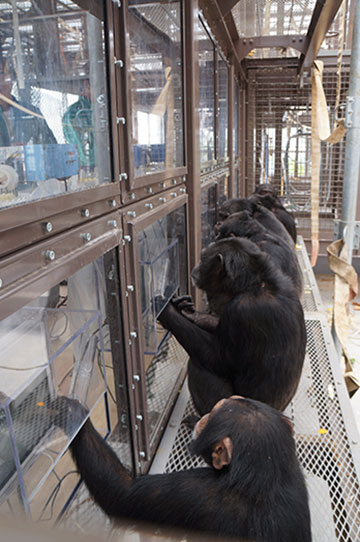
Satoshi Hirata, Ph.D.
Director, Professor, Wildlife Research Center, Kyoto University
What are human beings? What is in the minds that inquire about human beings? Starting with such questions, I entered into the academic world to study nonhuman primates from comparative cognitive perspectives. Since graduate school, the main target of my research has been the chimpanzee, one of the closest living relatives of humans. I aim to explore the evolution of the human mind through the investigation of the social intelligence in great apes... [continue reading]
-
Sep 2013-Professor, Wildlife Research Center, Kyoto University
(Director since Apr 2025) -
Sep 2011 - Aug 2013Program-specific Associate Professor, Primate Research Institute, Kyoto University
-
Apr 2010 - Aug 2011Visiting Associate Professor, Primate Research Institute, Kyoto University
-
Apr 2008 - Aug 2011Chief Scientist, Great Ape Research Institute of Hayashibara Inc.
-
May 2002 - Mar 2008Head Researcher, Great Ape Research Institute of Hayashibara Inc.
-
Apr 2001 - Apr 2002JSPS Research Fellow (PD)
-
Apr 1998 - Mar 2001JSPS Research Fellow (DC1)
-
2001Ph.D., Graduate School of Science, Kyoto University
-
1998M.Sc., Graduate School of Science, Kyoto University
-
1996B.Sc., Faculty of Science, Kyoto University
Book Capters
Research Sites

The first and only sanctuary for chimpanzees and bonobos in Japan
My study site for work with chimpanzees and bonobos, the great ape species, is Kumamoto Sanctuary. Kumamoto Sanctuary is the first and only sanctuary for chimpanzees and bonobos in Japan. It is located in Kumamoto prefecture, approximately 800km southwest of Kyoto University's main campus.
In Japan, no chimpanzees whatsoever are used in laboratory research. All of the chimpanzees formerly involved in biomedical research have now been retired and are housed comfortably at Kumamoto Sanctuary. The last three chimpanzees that still remained in another biomedical research facility were transferred to Kumamoto Sanctuary on May 15th, 2012, which marked the end of housing chimpanzees in biomedical facilities in Japan. The Kumamoto Sanctuary staff are passionately committed to enhancing the physical and psychological well-being of the chimpanzees and bonobos housed at the Sanctuary.

We have used computer-controlled touch screens, eye-trackers, and infra-red thermography, among other methods, to investigate the minds of chimpanzees and apes at Kumamoto Sanctuary. Using these technologies, our research has revealed the apes' long-term memory of single events, implicit false-belief comprehension, attention to conspecific pictures and videos, and skin temperature changes in response to emotional videos. With developing method to make attractive movies for the apes, we could prove that the apes remembered the storyline of the movie and that the apes showed some level of understanding about the mental states of the characters who appeared in the movie.
Other scientific studies, focused on ape welfare, have included the evaluation of hair cortisol as an indicator of stress, the change in hair cortisol levels in different housing conditions and social situations, the relationship between the frequency of social play and social tension, and the diagnosis and care of a blind chimpanzee with Down syndrome. Through this research, I hope to contribute to the understanding and captive welfare of our closest living relatives.
Last but not least, it is essential to establish a good relationship with the chimpanzees and bonobos before we can conduct a good study. Each individual ape has a different personality; thus, we need to thoroughly understand each individual's characteristics by close and patient observations of everyday life behavior.

Aiming to better understand human beings
In addition to the study of chimpanzees and bonobos, I have also started to investigate the behavior of feral horses at Serra D'Arga, Northern Portugal. At there once-domesticated horses live in natural environments, outside of human control. By studying horses that are phylogenetically distant from primates, we can broaden our understanding of the evolution of the human mind and human behavior.
Miscellaneous

 orcid.org/0000-0002-1026-6270
orcid.org/0000-0002-1026-6270